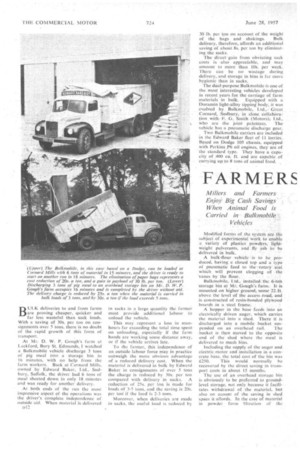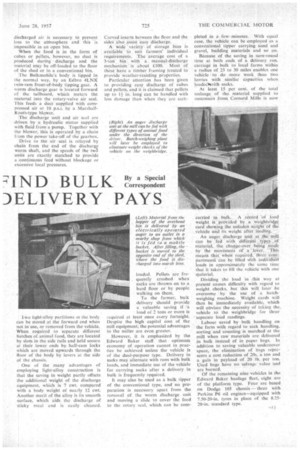FARMERS
Page 60

Page 61

If you've noticed an error in this article please click here to report it so we can fix it.
=IND BULK 3ICorrespondenta
Specia l
3ELIVERY PAYS
BULK deliveries to and from farms are proving cheaper, quicker and far less wasteful than sack loads. With a saving of 30s. per ton on consignments over 5 tons, there is no doubt of the rapid growth of this form of transport.
At Mr. D. W. P. Gough's farm at Lackford, Bury St. Edmunds, I watched a Bulkmobile vehicle discharge 3 tons of pig meal into a storage bin in 16 minutes, with no help from the farm workers. Back at Cornard Mills, owned by Edward Baker, Ltd., Sudbury, Suffolk, the driver had 6 tons of meal sheeted down in only 18 minutes and was ready for another delivery.
At both ends of the run the most impressive aspect of the operations was the driver's completeindependence of outside aid. When material is delivered in sacks in a large quantity the farmer must provide additional labour to unload the vehicle.
This may represent a loss in manhours far exceeding the total time spent' on unloading, especially if the farm hands are working some distance away, or if the vehicle arrives late.
To the farmer, this independence of an outside labour force may in practice outweigh the more obvious advantage of a reduced delivery cost. When the material is delivered in bulk by Edward Baker in consignments of over 5 tons the charge is reduced by 30s. per ton compared with delivery in sacks. A reduction of 25s. per ton is made for loads of 3-5 tons, and the saving is 20s. per ton" if the load is 2-3 tons.
Moreover, when deliveries are made in sacks, the useful load is reduced by 30 lb. per ton on account of the weight of the bags and shakings. Bulk delivery, therefore, affords an additional saving of about 8s, per ton by eliminating the sacks.
The direct • gain from obviating sack costs is also appreciable, and may amount to more than 10s. per week. There can be no wastage during delivery, and storage in bins is far more hygienic than in sacks.
The dual-purpose Bulk mobile is one of the most interesting vehicles developed in recent years for the carriage of farm materials in bulk. Equipped with a Duramin tipping body, it Was evolved by Btilkmobile, Ltd.,: Great Cornard, Sudbury, in _close ctillahOration with F. G. Smith (Motors); Ltd.,
who are the joint patentees. The vehicle has a pneumatic discharge gear. . Two Bulkmobile carriers are included in the Edward Baker fleet of 11 lorries. Based on Dodge 105 chassis, equipped with Perkins p6 oil engines, they are of the standard type. They have a capacity of ROO cu. ft. and are capable of carrying up to 8 tons of animal food. .
IVIoditied forms of the system are the subject of experimental work to enable -avariety of plastics .powders, Iight weight pulverants, and fly ail' to be delivered in bulk.
A bulk-flour vehicle is to be produced, having a closed top and a type of pneumatic feed to the rotark seal which will prevent clogging of the vanes by the flour... • : Bulkmobile, ltd., installed. the 6-tolt storage bin at Mr. Gough's farm. It is mounted on higher ground,. some 22,ft. above the level of the access .road, and constructed of resin.-honded plywood hoards -in a .steel frame: A hopper irt the base feeds into an electrically driven auger, which carries the material into a shed. There it is discharged into a mobile bucket sus pended on an overhead rail. The bucket is then moved to the opposite end of the shed where the meal is delivered to mash bins.
Including the supply of the auger and electric, motor and installation in a concrete base. the total cost of the bin was 1250. This would normally he recovered by the direct saving in transport costs in about 15 months.
The use of an overhead storage bin is obviously to be preferred to groundlevel storage, not only because it facilitates withdrawal of the material, but also on acount of the saving in shed space it affords. In the case of material in powder form filtration of the
discharged air is necessary to prevent loss to the annosphere and this is impossible in an open bin.
When the food is in the form of cubes or pellets, however, no dust is produced during discharge and the material May be off-loaded to the floor of the shed or to a conventional bin.
The Buflcmobile's body is tipped in the normal way, by an Edbro 4LNX twin-ram front-of-body tipping gear. A worm discharge gear is located forward of the tailboard, which meters the material into the rotary-valve air seal. This feeds a duct supplied with compressed air at 10 p.s.i. by a MarshallRoots-type blower.
The discharge unit and air seal are driven by a hydraulic Motor supplied with fluid from a pump. Together with the blower, this is operated by a chain from the power take-off of the gearbox.
Drive to the air seal is relayed by chain from the end of the discharge worm shaft, and the speeds of the twgri units are exactly matched to provide a continuous feed without blockage or excessive local pressures.
light-allOy partitions in the body can be stored at the forward end when nOt in use, or removed from the vehicle. When required to separate different batches of animal food, they are located by slots in the side rails and held secure at their lower ends by half-cam locks which are moved upwards through the floor of the body by levers at the side of the chassis.
One of the many advantages of employing light-alloy construction is that the saving in weight partly offsets the additional weight of the discharge equipment, which is 7 cwt. compared with a body weight of nearly 12 cwt. Another merit of the alloy is its smooth surface, which aids the discharge of sticky meal and is easily cleaned.
Curved inserts between the floor and the sides. also, assist "easy discharge. A wide va riety • of storage bins is available to . snit farmers' individual requirements. The average cost of a 3-ton bin with a manual-discharge mechanism is about £100. Most • of these. have a timber framing treated to provide weather-resisting ptoperties.
Particular attention has been given to providing easy discharge of cubes and pellets, and it is claimed that pellets up to 11 in. long can be handled with less damage that.' when they are sack
loaded. Pellets are frequently crushed when sacks are thrown on to a hard floor or by people walking on them.








































































































































